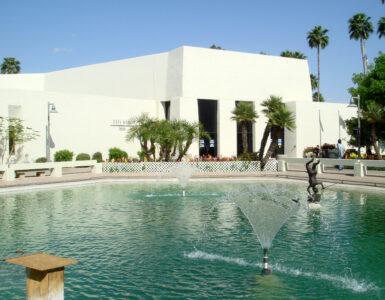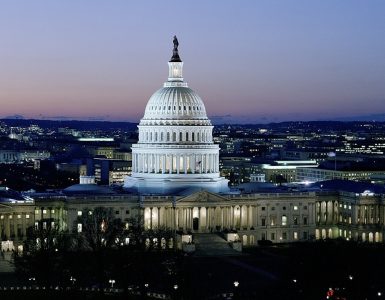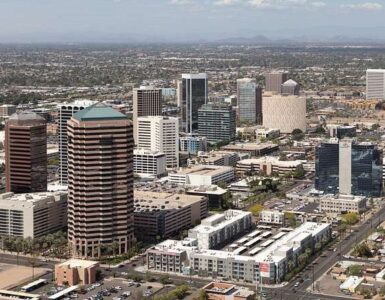Arizona is poised to be a leader in a new American space race, with aerospace and defense experts advocating for a new ‘spaceport’ in the state.
“Arizona does have a major play in this, and we should jump in with both feet,” said Julie Engel, president and CEO of the Greater Yuma Economic Development Corporation (GYEDC). “We’re on the middle-beginning of this industry sector, especially in the small [satellites], and the industry is projected to grow so rapidly, and if we get in now we’re going to grow with it.”
For the first time since 1972, the United States is racing its competitors — namely Russia and China — to the moon and beyond. The U.S. government aims to have astronauts on the moon again by 2024, Vice President Mike Pence announced Tuesday.
Spaceports have already been established in California, New Mexico and Florida, and Houston and Denver have each announced plans for their own. These facilities have the infrastructure and technology to launch spacecraft into orbit for exploration, defense and commercial travel.
A number of companies have been quietly entering the Arizona space-travel arena, including Terran Orbital, Vector, Myriorta, Hiber, Spaceflight Industries and AQST Space Systems — most producing small satellites for use in space exploration, travel and cloud-based internet services.
“There [are] just so many companies in this space already that have done a phenomenal job raising capital,” Engel said. “Vector is one I’m very, very proud of. They have already raised over $100 million, and they’ve attracted some of the really big players in this — Morgan Stanley is one of their investors.”
The Arizona Spaceport Alliance, a nonprofit organization founded by Karyn MacVean and Benjamin Hernandez, is focused on exploring the potential benefits — or drawbacks — of building a spaceport in Arizona.
“Benjamin and I saw other states really start to examine spaceports with respect to business development and attracting companies,” MacVean said. “We didn’t feel or see Arizona making strides in that arena and really wanted to help with the education effort with regard to answering some of the questions, because it’s a complicated development, it’s a complicated endeavor, and there’s a lot of questions to answer… to make sure that it’s the right thing for a region.”
MacVean and Hernandez travel the state speaking with legislators and the public about what a spaceport would mean and how it might impact the state, and the group recommends experts for governments or authorities that want more information.
“We just go around and facilitate conversation,” MacVean said. “We’ve got a very positive business environment to operate out of which supports new ideas and innovation. And we certainly have the wherewithal to understand what that new space business need is and really explore how our population base can meet their needs in terms of quality employment and jobs that would serve each of these communities that a spaceport might fit into.”
Arizona has long-standing expertise in aerospace and defense, including manufacturing, operations and testing for aviation. The space industry, including construction of a spaceport, is a “logical progression” to a growing industry that combines the best of the aerospace, defense and national security sectors, said Sally Harrison, president of the Mesa Industry and Defense Council.
“Arizona, as a resilient state, has the ideal weather conditions to continue to expand its involvement in space, through the [John] McCain Yuma Spaceport,” Harrison said. “Arizona can and will become a ‘back-up’ to other states and their spaceports, as the industry will need good weather conditions, clear skies and the restricted air space that we have. Many of our Mesa Industry and Defense Council members are already engaged in space, such as Boeing, Northrop Grumman, AQST Space Systems and Nammo Talley, and we expect them to take advantage of an ever-stronger supply chain, to lower their operational costs while continuing to provide good quality products.”
The proposed John McCain Yuma Spaceport is something the GYEDC has been pushing for, and Yuma County has the necessary combination of clear skies, proximity to the ocean and military airspace free of commercial airline traffic.
“Being a military-controlled airspace, our location would be very attractive for counter-measures, meaning if an enemy did take out some satellites that would make us… completely defenseless, or just jam all our communications and make our technology ineffective, we could scramble and launch counter-measures pretty quickly,” Engel said.
Yuma International Airport and Marine Corps Air Station Yuma share one facility, which includes a 17,300-foot runway and another 14,000-foot runway for horizontal rocket launches, and another location further south has the potential for vertical launches, Engel said.
The GYEDC and partner space startups are primarily focused on launching small satellites — 600 kilograms or less — using a horizontal launch.
“The footprint that would be needed to go bigger than that would present problems for our assets that are located down there,” Engel said. “There’s a state prison, there’s some housing, and we have San Luis [Río Colorado], Sonora, to take into consideration.”
The smaller satellite companies have faced backlash from commercial airlines because spaceports often force airlines to reroute planes or ground flights for launches, but that wouldn’t be a problem in Yuma, she said.
“Where this is located, the trajectory appears to be very safe, and there won’t be any major disruptions,” Engel said. “They’ll be over the Sea of Cortez in approximately seven seconds, so if there was a catastrophic event it would most likely happen over water.”
In order to be successful, a spaceport needs strong support from both sides of the political aisle, as well as a “strong pipeline of talent” through the local education system to prepare professionals in science, engineering and technology, Harrison said.
“High-tech jobs bring about value, good pay and a strong fiscal revenue base to continue making Arizona competitive in the national and international arenas,” she said.
The GYEDC is currently in the process of seeking necessary Federal Aviation Administration approval for a spaceport, which involves a number of studies regarding the launch trajectory and environmental impact.
Arizona senior Sen. Kyrsten Sinema, ranking member of the Senate Subcommittee on Aviation and Space, has been a vocal supporter of Arizona’s role in the burgeoning space industry.
“I recognize the challenges we face as we try to maintain America’s leadership in space,” Sinema said during a Senate Commerce Committee hearing on the new global space race. “Our competitors across the globe continue to make significant advances in space exploration and development, and we must address this challenge head-on with strong bipartisan solutions.”
















Add comment